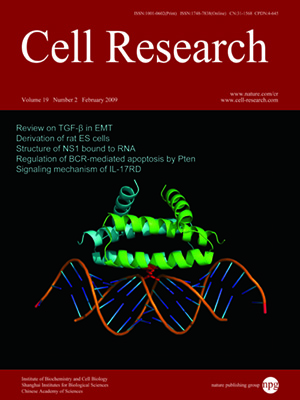
Volume 19, No 2, Feb 2009
ISSN: 1001-0602
EISSN: 1748-7838 2018
impact factor 17.848*
(Clarivate Analytics, 2019)
Volume 19 Issue 2, February 2009: 236-246
ORIGINAL ARTICLES
Cell adhesion molecules regulate contractile ring-independent cytokinesis in Dictyostelium discoideum
Akira Nagasaki1, Masamitsu Kanada1,2 and Taro QP Uyeda1,2,3
1Research Institute for Cell Engineering, National Institute of Advanced Industrial Science and Technology (AIST), Tsukuba, Ibaraki 305-8562, Japan
2Graduate School of Life and Environmental Sciences, University of Tsukuba, Tsukuba, Ibaraki 305-8572, Japan
3Biomedicinal Information Research Center, National Institute of Advanced Industrial Science and Technology (AIST), Koto, Tokyo 135-0064, Japan
Correspondence: Akira Nagasaki,(nagasaki@aist.go.jp )
To investigate the roles of substrate adhesion in cytokinesis, we established cell lines lacking paxillin (PAXB) or vinculin (VINA), and those expressing the respective GFP fusion proteins in
Dictyostelium discoideum. As in mammalian cells, GFP-PAXB and GFP-VINA formed focal adhesion-like complexes on the cell bottom.
paxB- cells in suspension grew normally, but on substrates, often failed to divide after regression of the furrow. The efficient cytokinesis of
paxB- cells in suspension is not because of shear forces to assist abscission, as they divided normally in static suspension culture as well. Double knockout strains lacking
mhcA, which codes for myosin II, and
paxB or
vinA displayed more severe cytokinetic defects than each single knockout strain. In mitotic wild-type cells, GFP-PAXB was diffusely distributed on the basal membrane, but was strikingly condensed along the polar edges in mitotic
mhcA- cells. These results are consistent with our idea that
Dictyostelium displays two forms of cytokinesis, one that is contractile ring-dependent and adhesion-independent, and the other that is contractile ring-independent and adhesion-dependent, and that the latter requires PAXB and VINA. Furthermore, that
paxB- cells fail to divide normally in the presence of substrate adhesion suggests that this adhesion molecule may play additional signaling roles.
Cell Research (2009) 19:236-246. doi: 10.1038/cr.2008.318; published online 9 December 2008
FULL TEXT | PDF
Browse 2105


